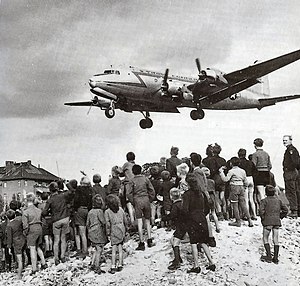| Berlin Blockade | |||||||
|---|---|---|---|---|---|---|---|
| Part of the Cold War | |||||||
 West Berliners watch a Douglas C-54 Skymaster land at Tempelhof Airport, 1948 | |||||||
| |||||||
| Belligerents | |||||||
|
|
| ||||||
| Commanders and leaders | |||||||
|
|
| ||||||
| Casualties and losses | |||||||
| None |
In aircraft accidents: 39 British, 31 Americans killed and 1 Australian killed 15 German civilians killed | ||||||
| History of Berlin |
|---|
 |
| Margraviate of Brandenburg (1157–1806) |
| Kingdom of Prussia (1701–1918) |
| German Empire (1871–1918) |
| Free State of Prussia (1918–1947) |
| Weimar Republic (1919–1933) |
| Nazi Germany (1933–1945) |
| West Germany and East Germany (1945–1990) |
|
| Federal Republic of Germany (1990–present) |
| See also |
The Berlin Blockade (24 June 1948 – 12 May 1949) was one of the first major international crises of the Cold War. During the multinational occupation of post–World War II Germany, the Soviet Union blocked the Western Allies' railway, road, and canal access to the sectors of Berlin under Western control. The Soviets offered to drop the blockade if the Western Allies withdrew the newly introduced Deutsche Mark from West Berlin.
The Western Allies organised the Berlin Airlift (German: Berliner Luftbrücke, lit. "Berlin Air Bridge") from 26 June 1948 to 30 September 1949 to carry supplies to the people of West Berlin, a difficult feat given the size of the city and the population.[1][2] American and British air forces flew over Berlin more than 250,000 times, dropping necessities such as fuel and food, with the original plan being to lift 3,475 tons[clarification needed] of supplies daily.[citation needed] By the spring of 1949, that number was often met twofold, with the peak daily delivery totalling 12,941 tons.[3] Among these was the work of the later concurrent Operation Little Vittles in which candy-dropping aircraft dubbed "raisin bombers" generated much goodwill among German children.[4]
Having initially concluded there was no way the airlift could work, the Soviets found its continued success an increasing embarrassment. On 12 May 1949, the USSR lifted the blockade of West Berlin, due to economic issues in East Berlin, although for a time the Americans and British continued to supply the city by air as they were worried that the Soviets would resume the blockade and were only trying to disrupt western supply lines. The Berlin Airlift officially ended on 30 September 1949 after fifteen months. The US Air Force had delivered 1,783,573 tons (76.4% of total) and the RAF 541,937 tons (23.3% of total),[nb 1] totalling 2,334,374 tons, nearly two-thirds of which was coal, on 278,228 flights to Berlin. In addition Canadian, Australian, New Zealand and South African air crews assisted the RAF during the blockade.[5]: 338 The French also conducted flights, but only to provide supplies for their military garrison.[6]
American C-47 and C-54 transport airplanes, together, flew over 92,000,000 miles (148,000,000 km) in the process, almost the distance from Earth to the Sun.[7] British transports, including Handley Page Haltons and Short Sunderlands, flew as well. At the height of the airlift, one plane reached West Berlin every thirty seconds.[8]
Seventeen American and eight British aircraft crashed during the operation.[9] A total of 101 fatalities were recorded as a result of the operation, including 40 Britons and 31 Americans,[8] mostly due to non-flying accidents.
The Berlin Blockade served to highlight the competing ideological and economic visions for postwar Europe. It played a major role in aligning West Berlin with the United States and Britain as the major protecting powers,[10] and in drawing West Germany into the NATO orbit several years later in 1955.
- ^ Journey Across Berlin (1961). Universal Newsreel. 1957. Retrieved 22 February 2012.
- ^ Air Force Story, The Cold War, 1948–1950 (1953). Universal Newsreel. 1953. Retrieved 22 February 2012.
- ^ The American People: Creating a Nation and a Society. New York: Pearson Longman, 2008. p. 828.
- ^ Smoler, Fredric (April/May 2003). "Where Berlin and America Meet Archived 28 August 2008 at the Wayback Machine" American Heritage. Retrieved 29 July 2010.
- ^ "5 – National Security". South Africa: a country study. Federal Research Division, Library of Congress. 1997. ISBN 0-8444-0796-8.
- ^ Jacques Bariéty (1994). "La France et la crise internationale du blocus de Berlin". Histoire, économie et société; Volume 13; numéro 1. pp. 29–44. Retrieved 11 June 2017.
- ^ Berlin Airlift: Logistics, Humanitarian Aid, and Strategic Success Archived 16 January 2007 at the Wayback Machine, Major Gregory C. Tine, Army Logistician
- ^ a b Cite error: The named reference
turner27was invoked but never defined (see the help page). - ^ Tunner 1964, p. 218
- ^ Daum, Andreas W. (2000). "America's Berlin, 1945‒2000: Between Myths and Visions". In Trommler, Frank (ed.). Berlin: The New Capital in the East (PDF). The American Institute for Contemporary German Studies, Johns Hopkins University. pp. 49–73. Retrieved 2 March 2021.
Cite error: There are <ref group=nb> tags on this page, but the references will not show without a {{reflist|group=nb}} template (see the help page).